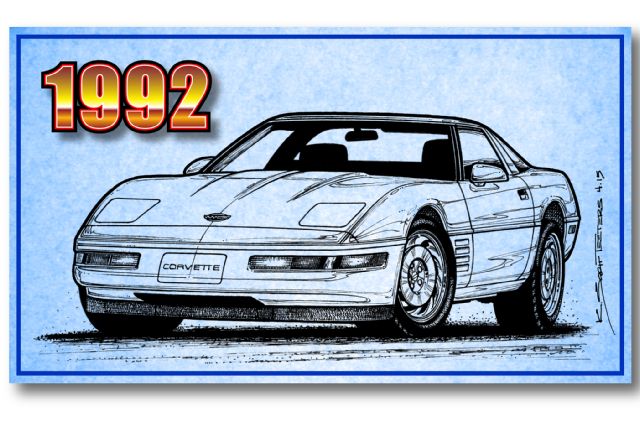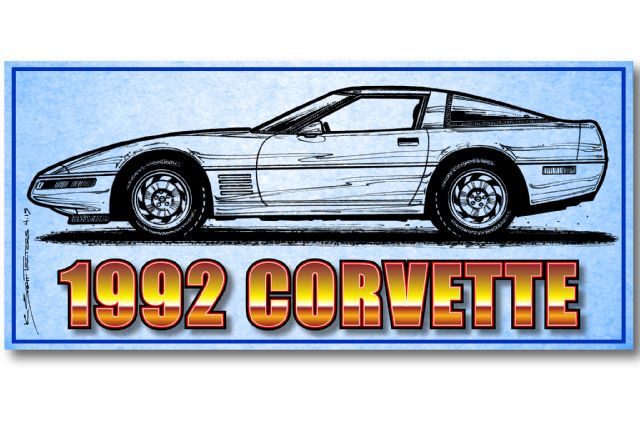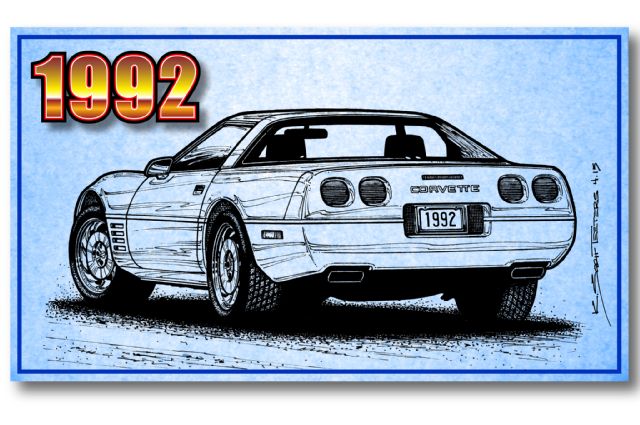
The Illustrated Corvette Designer Series No. 220: Mid-Cycle C4 Makeover
Art & Words by Scott Teeters as republished from Vette Magazine’s SuperChevy.com website
The mid-cycle makeover of the C4 was rolled out so quietly and with such stealth, it was hardly noticed. Things were tough inside GM in the early ’90s, so the major upgrades were on the installment plan. What is undeniable though is that the 1992 Corvette is very different from the 1989 Corvette. Here’s how things unfolded.
Beginning in the late ’70s and into the early ’80s, car styling became very linier. Curves and rounded corners were replaced with straight lines and hard angles. The trend was in full swing when the C4 was being designed. While the basic “shark” proportions are still part of the C4, the voluptuous curves and hips were straightened out. The C4’s interior was consistent with the exterior – mostly straight lines.
“Digital” was the hot new trend, so the C3’s round gauges with swinging pointers were replaced with digital numerical readouts, inspired by the F-14 Tomcat fighter jet. All information was numerical with colored bar graph displays. Fuel consumption and remaining range was displayed in either English or metric. In the day it was very cool, but like most “trendy” things, it got old fast and by the late ’80s it was time for a major update.

Not since the ’57 to ’58 transition had the Corvette’s interior been so radically changed. Chevrolet called the new ’90 dash a “hybrid instrument panel” that had a digital speedometer with analog tachometer and secondary gauges. The design was no longer straight across and spread out, but curved up from the right side of the new console and across the front of the driver. Everything on the left side of the dash was strictly for the driver. Chevrolet also called it “jet fighter-like.”
The impetus for the new dash was the now-required airbag system for the driver and passenger, thus necessitating an all-new steering wheel and space on the passenger side for the airbag. So not only was the ’90 Corvette safer for the driver and passenger in the event of an unfortunate event, the new interior digs were a nice refresh. Since 1990, I have never heard anyone wax nostalgic for the old days of the early C4 digital dash design. Aside from the new cabin, the ’90 Corvette is practically identical from the ’89 Corvette.
For Corvette spotters, identifying ’84 to ’90 Corvettes is a matter of different wheels, minor details, and the 1990 model’s revised dash, making ’91 a breakthrough year, but with one slightly confusing detail. The front and rear bumper covers were redesigned to move the overall look away from totally angular, to softer and rounder. You can view this as the trend that lead to the C5. The nose had a curved transition from the front to the sides and the driving lights/sidemarkers wrapped around from the front to the side. The sidemarker lights were no longer separate units standing alone in front of the wheelwells, as they’d been since 1968. The lower edge transition from the front leading edge of the bumper cover that leads down to the front air dam and spoiler was now slightly curved. The front fender gills were changed from the two vertical slits to four horizontal strakes. The new side vents would carry through to ’94 and the front and rear bumper covers to ’96.
Another nice change was the addition of body-colored side moldings. Gone was the black line splitting the upper and lower halves of the Corvette. Compounding the identification challenge was the restyled wheels. The new design used the previous center button hub, but with eight connecting fan-like vanes that actually pulled air through to help cool the brakes. This wheel design lasted through to the end of the C4 line in ’96. Between the bumper covers, fender vents and wheels, it’s nearly impossible to tell the difference between a ’91 to ’94 Corvette.
About the new rear bumper cover. This was a bit of a sore point for C4 ZR-1 owners because the “square taillights with rounded corners” look was the same as the hyper-expensive ZR-1. Everything from the door back on a ZR-1 was unique, but now the base Corvette looked very much like the ZR-1, minus the “ZR-1” badge on the right side of the rear bumper cover. In retrospect, the ZR-1 should have had a more distinctive look that wasn’t shared with the base model. Perhaps the “four vertical vent-look” from the GTO body kit and something special on the hood, a la the C6 Z06/ZR1 would have set the exotic ZR-1 apart from the regular ’91 to ’95 Corvettes.

With the interior and exterior all spruced up for the roaring ’90s, all that was left to add was more grunt, and OH-WOW, did the Chevrolet engineers deliver. From 1984 to 1992, except for the jump from the ’84 205hp Cross-Fire Injection to the ’85 230hp Tuned Port Injection engines, horsepower increases were just 5 hp per year, topping out at 250 hp in 1990. Chevrolet stunned the Corvette world by not only the resurrection of a classic “LT1” moniker, but with a whopping 50hp bump to 300 hp. The baddest C3 LT-1 was the 70 1/2 version that was rated at 370 (gross) horsepower. The new C4 LT1’s (net) 300 hp was at least equal to or slightly more powerful than the performance-golden-days classic. Quarter-mile times vary, but the C4 LT1 Corvettes are easily capable of mid-13s at 105 mph in stock form, indicating that the new engine is producing slightly more power than the old classic, with a lot of potential left in what was to be the last version of the classic small-block Chevy engine.
So how did Chevrolet engineers accomplish such a feat? Hot rod tricks! Yes, the basics. The new LT1 had the following goodies that any hot rodder would have done in the olden days. The exhaust system was less restrictive thanks to two catalytic converters and two oxygen sensors (one for each bank) for less restriction. Compression was bumped up to 10.5:1. The camshaft had a revised profile and the heads were the new free-flow design. The new multiport fuel-injection system wasn’t as sexy-looking with the curved intake tubes used on the L98 setup, but it was more efficient and had a lower profile by 3 1/2 inches. The cast-iron cylinder block was new with more beef and set up for the new gear-driven water pump, reverse-flow cooling, and front-mounted ignition system. The new Opti-Spark ignition system helped with the higher compression and emissions, but later proved to be problematic. Overall, the new LT1 weighed 21 pounds more than the L98, thanks to the use of cast-iron exhaust manifolds that replaced the L98’s tube steel headers. While we all like to see less weight on a Corvette, the slightly heavier LT1 was worth every pound.
Let’s talk price. In 1989, the base model Corvette coupe listed for $31,545 and the convertible at $36,785. By 1992, the price had only gone up $2,090 to $33,635 for the coupe and up $3,360 to $40,145 for the convertible. So for coupe buyers, an extra two grand got you a new interior, updated exterior, and 50 more horsepower. Looks like a bargain to me.
The base model Corvette coasted out the rest of its days to ’96 as is, except for new fender vents in ’95, the optional 330hp LT4 engine in ’96 and various other minor improvements. The flagship ZR-1 exited after 1995, and for the C4’s final year Chevrolet dished up the Collector Edition and the 330hp LT4-powered Grand Sport. The Grand Sport’s LT4 engine was available on all ’96 Corvettes. The C4 Corvette lasted longer than Dave McLellan ever anticipated when it was being designed in the early ’80s. The three-part mid-cycle refresh was his final contribution to the Corvette before his retirement in 1992. Thanks Dave! Thanks Corvette team! Good job!
